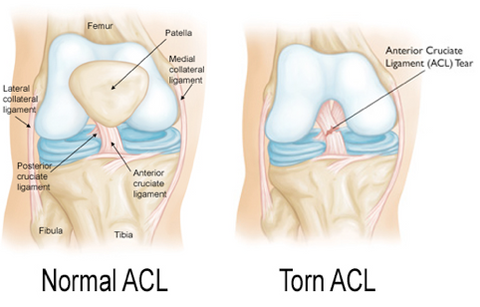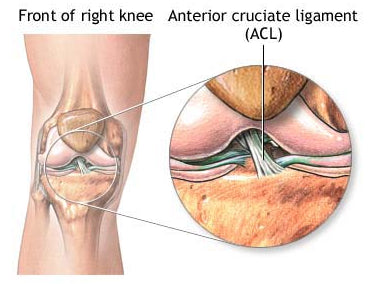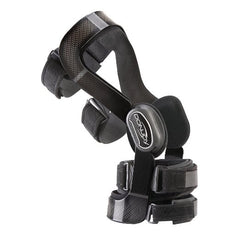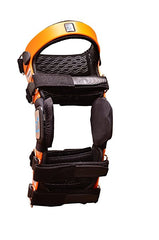ACL Injuries for Best ACL Knee Brace

The ACL is a crucial ligament in the knee; it is the main stabilizer for the knee joint. When the ACL ligament is damaged it can lead to giving away of you knee and general instability. If your knee continuously gives away it can be damaging to other parts of your knee joint, like the cartilage. Once you have injured you ACL and plan on returning to sport and exercise it is very important to purchase a high quality knee brace. Someone who has damaged their ACL will be at a higher risk for re-injuring that same ACL for the initials 12 months.
There are three reasons you may want to purchase a knee brace for an ACL injury. They can be used to aid your knee instead of getting surgery, used while waiting for surgery, or while recovering from surgery. The brace will provide support and stability to your knee while the ligament is weak. An ACL brace will provide the physical support you need with ACL injuries but also help with the mental aspect as well. Wearing a brace that is going to protect your ligaments allows you to be at ease during activity, it also provides to yourself and others that you are injured or have just had surgery.
ACL Injuries
ACL injuries are one of the most common knee injuries in any high intensity sport. Injuries to the ACL can range from mild to severe. However, it is more common to have a complete rupture then just a sprain. More commonly the injury is sustained in a non-contact movement, rather than a direct contact blow to the knee. Below is an overview of what you should know about ACL injuries.
The anterior cruciate ligament (ACL) is located in the middle of the knee joint and helps connect the thigh bone (femur) to one of the shin bones (tibia). The purpose of this ligament is to prevent the shin bone from sliding out in front of the thigh bone. The ACL can be injured in several ways including, changing direction rapidly, stopping suddenly, landing incorrectly, over extension, or from a direct contact or collision. When one of these actions does cause an ACL injury it means that the ligament has been stretched too far and may have partial tears or the ligament has experienced a full blown tear.
Anatomy

The anterior cruciate ligament is one of four ligaments that helps hold the three bones of the knee joint together. The ACL in located on the inside of the knee joints and runs from the back where it attaches to the femur to the front where it attaches to the tibia. It crosses in front of the posterior cruciate ligament and together these two ligaments control the forward and backward motion of the knee. Specifically, the ACL prevents the tibia from sliding to far forward and help maintain rotational control.
Risk Factors
There are five main risk factors that can put someone at a higher risk for an ACL injury. Due to anatomical and hormonal differences between men and women, studies have shown that females are at a higher risk for ACL injuries. Different muscle strength and weakness can also contribute to an ACL injury. A strong quad dominance and weak posterior muscles like your hamstrings which ends up pulling the tibia forward and placing more stress on the ACL. Weak core muscles is another risk factor, a strong core is essential for supporting your trunk and executing smooth and correct movements of the body. Shoe type and playing surface all play a role in increasing the risk of an injury.
Mechanism/Cause of Injury
ACL injuries can happen on contact and in noncontact movements. Non-contact is actually more common, meaning it occurs simply through body position/body movement. A combination of these movements often leads to an injury: inward force on the knee, quad contraction, the knee is near full extension, and there is some sort of internal or external rotation. This can be achieved in several ways:

Cutting and changing direction
Stopping suddenly
Landing on one leg
Slowing down while running
Direct contact or collision
There are three different types of ACL injuries, Grades 1, 2, and 3. Grade one is when there is only a partial tear of few fibers in the ACL ligament and the knee can still function. Grade 2 involves more pain and a greater percentage of torn fibers. The ligament will be loose and lose a lot of function. A grade 3 tear will be a complete tear of the ACL ligament and will leave the knee very unstable. A grade 3 tear almost always requires surgery if the athlete plans to return to the same level of play
Symptoms
Athletes will often say they felt a shift in their knee or heard a pop followed by immediate pain. Swelling will be large and occur very quickly after the injury as well as decreased range of motion. Pain can be hard to pin point sometimes, often feeling like the whole knee is painful, but pain in the anterior (front) aspect of the knee is common. If the ACL injury is not diagnosed and the athlete returns to play, they will often have moments where the knee feels very unstable and shifts. This will be followed by pain and swelling.

Pain and swelling
Loss of range of motion
Popping sound at time of injury
Unstable/give away feeling
Treatment
Treatment will depend on the severity of the injury. After the injury occurs the athlete should focus on decreasing swelling and maintaining range of motion. There are two paths to take, surgical and nonsurgical. Grades 1 and 2 will most likely not require surgery. Working with a physiotherapist they will often recommend pain free stretching and strengthening of the muscles surrounding the knee. Bracing is also a great idea if the athlete is going to be participating in high risk activities. For information on the best braces for an ACL injury click here.
If surgery is a possibility, there is a little controversy around it. The recovery time after surgery can be about 8-12 months and very limiting on your daily movement to begin. If you are a recreational athlete that doesn’t plan to return back to high intensity and high risk sport then non-surgical rehab and bracing may be a better option. However most professionals would recommend a ACL reconstruction surgery if elite performance is your goal.
Types of ACL Knee Braces
ACL braces range from top of the line hinged braces to mild instability braces. A mild to moderate ACL brace will work best for mild to moderate ACL instabilities. These braces are also good for people who participate in high risk sports where the risk of an ACL tear is high. A mild to moderate instability brace will be designed with adjustable straps with built in supports to help stabilize the knee.
When suffering from a more severe ACL injury or recovering from surgery a more severe instability brace is required. These braces will contain a flexion/extension hinge that provides resistance from the knee moving into at-risk positions. These braces provide maximum support to put your mind at ease while returning to sport.
How Does a Knee Brace Help for ACL Injuries?
These types of braces are specially designed to reduce the amount of force and strain that is being placed on the ACL. The hinge of the brace is designed to allow the knee joint to move through its natural range of motion but still restrict the knee when it is moving into a high risk position. The brace should also contain some sort of leverage system that will decrease the amount on strain being placed on the ACL. These are crucial elements after an injury while an athlete is working on strengthening their knee and allowing them to get back to their previous level of activity.
Here are some of the best ACL knee braces on the market:
1.Donjoy Fullforce Ligament Brace

This brace is the next step down from the eXtreme Armor knee brace. It is designed to be used with mild to moderate ligament injuries and is suitable for contact and non-contact sports. This brace will provide an excellent amount of support but is not a heavy brace like many other hinged braces. It is very light weight and comfortable, contained “anti-migration ads to hold the brace in place.
2.Orthomen Functional ACL Knee Brace
Designed to provide stability and support following injury or reconstruction of the ACL/PCL/LCL, The Functional ACL Knee Brace features a lightweight sturdy frame lined with durable soft goods for the combination of optimum support and comfort. This is the perfect brace for those active patients needing additional support during recovery.
3.Braceit K2 ComfortLine Knee Brace

The Braceit K2 ComfortLine repersents the most comfortable, easy to use, and light weight knee brace, which is ideally suited for support in daily living without any hindrance. Braceit K2 comfortLine knee brace is a perfect companion for assistance with ligament injuries, sports injuries and mild osteoarthritis. The brace has been designed to give the best support during the dally activities as well light sports endeavors.
Note – This information has been taken from different internet sources.
- Choosing a selection results in a full page refresh.


2 comments
Mark Werre
This is a very nice brace for the price. I have had knee pain and issues on the outside of my knee from sports. I purchased this brace after reading the reviews previously posted, plus honestly, it looked pretty cool. I still experienced knee pain after the first use. But once the brace was “broken-in” I did not experience any pain. This is after about 2 hours of hard cardio sports activity (a lot of cutting and lateral movement). I took the advice of a lot of the other reviewers and purchased 1 size larger then my measurement. The brace fits snug and have not had any issues with the brace slipping. I am very happy with my purchase.
Ohsawe
I torned my ACL for football, and needed a support for my knee. The Orthomen Knee Brace works super good. The description says it all, and it deliver what is promised.